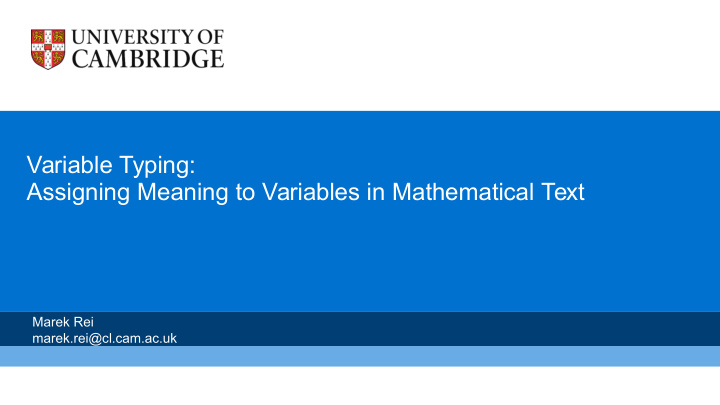



Variable Typing: Assigning Meaning to Variables in Mathematical Text Marek Rei marek.rei@cl.cam.ac.uk
Contributors Yiannos Stathopoulos Simon Baker Marek Rei Simone T eufel
Overview • The task of variable typing • The dataset for variable typing • Intrinsic evaluation • Extrinsic evaluation: mathematical IR
Introduction • T exts from many major fjelds of study heavily rely on mathematics to communicate ideas and results. • There’s often an “interaction” of two contexts: • The textual context (fmowing text) • Mathematical context (symbols and formulae). • In this work, we introduce a new task focusing on a particular interaction between these two contexts: the assignment of meaning to variables by surrounding text.
Introduction What is a “type” ? • Multi-word phrases drawn from the mathematical technical terminology (Stathopoulos and Teufel, 2016) • Types refer to – mathematical concepts (e.g., shape, number) objects (e.g., matrix, set) – algebraic structures (e.g., group, ring) – physical concepts (e.g., energy, temperature). – • Typically noun phrases
The Variable Typing Task Objective: Assign types to variables that appear in maths or scientifjc text. For example:
The Variable Typing Task Objective: Assign types to variables that appear in maths or scientifjc text. For example:
The Variable Typing task Objective: Assign types to variables that appear in maths or scientifjc text. For example:
The Variable Typing Task Objective: Assign types to variables that appear in maths or scientifjc text. For example:
The Variable Typing Task Why is this task useful ? • Downstream tasks: • Mathematical information retrieval (MIR) • T opic modelling • Symbol disambiguation • Plagiarism detection • Open response mathematical questions (Lan et al., 2015) • Can also be viewed as a relation extraction (RE) task. • Out of domain dataset for evaluating RE models and systems.
The Variable Typing Task We make four key assumptions/constraints about this task: 1. T yping occurs at the sentential level and variables in a sentence can only be assigned a type phrase occurring in that sentence. 2. Variables and types in the sentence are known a priori. 3. T ype relations in a sentence are independent of one another. 4. T ype relations in one sentence are independent of those in other sentences – given a variable v in sentence s, type assignment for v is agnostic of other typings involving v from other sentences.
Detecting Types Extend seed dictionary by Stathopoulos and T eufel (2016) from 10,601 types to 1.2 million types. Basic idea: use seed dictionary to determine known “supertypes”, then return candidate phrases with known types in their suffjx. Example known types: {algebra, lie algebra, tensor, riemannian manifold} expanded types: {coalgebra, cotensor, complete riemannian manifold, submanifold, isotropic submanifold, order cotensor}
The Variable Typing Data Set We constructed a corpus for variable typing: ● Using text from scientific articles in the MREC corpus (Líška et al., 2011) ● Identify variables in text using Symbol Layout Trees from MathML ● Select sentences for annotation, using stratified sampling based on the location of the sentence (intro, theorems, etc) and the number of variables.
The Variable Typing Data Set Human annotation and agreement: ● 2 annotators for agreement experiment Relation Labels ● 108 sentences/182 relations overlap Varying labels Fixed labels
The Variable Typing Data Set Human Annotation and Agreement ● 2 annotators for agreement experiment ● 108 sentences/182 relations overlap Results: • Annotators agree that a variable can be typed by its context? • Cohen’s Kappa 0.80 (substantial) • Given a variable is typable from its context, do the annotators agree on the type? • Accuracy 90.9% • Annotators agree that a variable is not typable • Cohen’s Kappa 0.61 (moderate)
Intrinsic Evaluation Objective : Evaluate machine learning algorithms on the task of variable typing Models / baselines : • Nearest type (naïve baseline, assign the nearest type) • SVM model by Kristiano et al. (2012), using hand-written rules as features • SVM+, adding features specific to our task • CNN model, classifying each possible edge • BiLSTM, formulated as a sequence labeling task
Intrinsic Evaluation - Results Model Precision Recall F1-Score Nearest type 30.30 82.94 44.39 SVM 55.39 76.36 64.21 SVM + 71.11 72.74 71.91 CNN 80.11 70.26 74.86 BiLSTM 83.11 74.77 78.98
Extrinsic Evaluation – MIR Mathematical Information Retrieval (MIR): ● Retrieval of mathematical information needs, expressed as text and formulae. ● Using the Cambridge University MathIR test collection (CUMTC) ● Queries and relevant documents are rich in mathematical types Example query: Example relevant document:
Extrinsic Evaluation – MIR Intuition : Enriching formulas with types from the text can be beneficial for MIR. ● Formulas are represented using Symbol Layout Trees (SLTs) ● For example, formulas x + y and a + b are represented is a similar way: LINEAR FORM LINEAR FORM WITHIN WITHIN WITHIN WITHIN WITHIN WITHIN ADJ ADJ + b a ADJ ADJ + y x OP VAR VAR OP VAR VAR ● However, if x,y may have type 'number', while a,b have type 'vector': LINEAR FORM LINEAR FORM WITHIN WITHIN WITHIN WITHIN WITHIN WITHIN ADJ ADJ + ADJ ADJ vector vector + number number OP VAR VAR OP VAR VAR
Extrinsic Evaluation - Results Using math-specific IR system Tangent (Pattaniyil et. al, 2014) Measuring mean average precision (MAP) Math-specific IR models Tangent Index Standard IR baselines Tangent Index Untyped Typed formulas formulas VSM BM25 No types .052 .046 .076 .079 in text Types .083 .139 in text Bold: difference statistically significant with all models at p < 0.05
Conclusions 1. We introduced the new task of variable typing 2. We have produced a new data set of 33,524 data points 3. Trained ML models for variable typing, with a BiLSTM sequence labeler performing best 4. Our extrinsic evaluation demonstrates that the data set is useful for downstream tasks 5. We make our variable typing data set available through the open data commons license For more information: http://www.cl.cam.ac.uk/~yas23/
Questions ? Thank you!

Recommend
More recommend